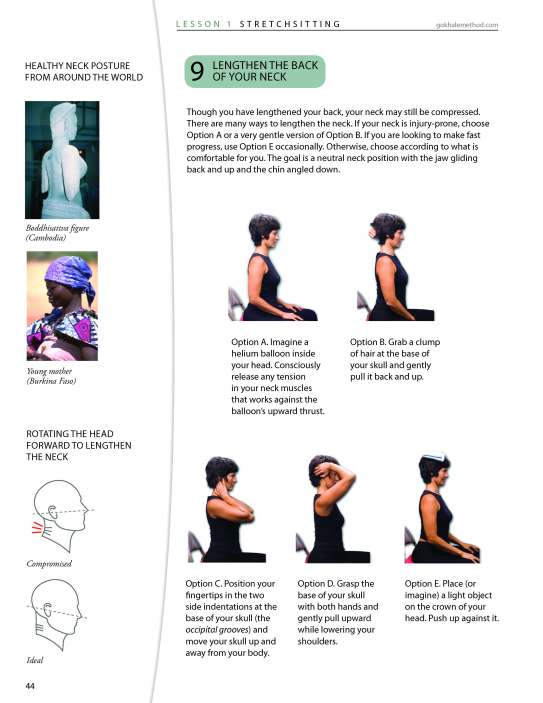Spectacl'r Posture
Is there a relationship between your eyeglasses/sunglasses and your posture? In the years I have been teaching people to restore their primal posture, I have discovered that glasses can hurt – or help - your posture, especially your neck posture. Here are some Gokhale Method guidelines to help you maintain, and even improve, your structure as you aid your vision.
1. Fit your glasses to you rather than fit yourself to your glasses. Begin by choosing the best posture you know, and then fit the glasses to your face. Is there enough glass to cover all the directions in which you are  likely to look? Often glasses do not extend enough above the level of the eye, thus encouraging you to raise your chin just so you can see through your glasses. The problem with raising your chin for long periods is this compresses the tissues in your neck including your discs, nerves, edges of the vertebrae and blood vessels. It also sets an unhealthy baseline of shortened neck muscles and can lead to chronic neck pain and discomfort. Instead, by selecting your frame carefully, you could use your glasses like a training device. Even if you have some postural distortion and compression in your neck, a carefully chosen pair of glasses could augment not only your vision, but also your posture.
likely to look? Often glasses do not extend enough above the level of the eye, thus encouraging you to raise your chin just so you can see through your glasses. The problem with raising your chin for long periods is this compresses the tissues in your neck including your discs, nerves, edges of the vertebrae and blood vessels. It also sets an unhealthy baseline of shortened neck muscles and can lead to chronic neck pain and discomfort. Instead, by selecting your frame carefully, you could use your glasses like a training device. Even if you have some postural distortion and compression in your neck, a carefully chosen pair of glasses could augment not only your vision, but also your posture.
2. Remember that your ophthalmologist, the frame manufacturers, and the vision testing setup are subject to the modern distorted posture paradigm. Don’t count on optimal feedback on this aspect of your fitting. Go in to your appointment with a clear understanding of how you would like your neck aligned and hold your  ground on this. The structure used to stabilize your head to do your vision testing usually forces you to crane your neck uncomfortably. Do your best to maintain good posture during this and all other parts of your eye exam, not only for the sake of your neck, but also because it’s a normal line of vision that you will give the most relevant readings.
ground on this. The structure used to stabilize your head to do your vision testing usually forces you to crane your neck uncomfortably. Do your best to maintain good posture during this and all other parts of your eye exam, not only for the sake of your neck, but also because it’s a normal line of vision that you will give the most relevant readings.
3. Choose glasses that have a reasonably secure fit. A loose fit might tempt you to lift your chin to keep your glasses balanced on the bridge of your nose.
4. Choose lightweight frames. Heavy frames have more of a tendency to  slide off your nose in actions like hiphinging and could induce you to raise your chin.
slide off your nose in actions like hiphinging and could induce you to raise your chin.
5. Choose a larger, thinner frame to allow for more peripheral vision. Wearing glasses and sunglasses inevitably reduces peripheral vision somewhat, but you want to minimize this and keep your eyes mobile and your eye muscles working. Our hunter gatherer ancestors had to have excellent peripheral vision to survive. In modern times, we don’t usually need peripheral vision to survive, but cultivating peripheral vision is known to help with myopia and calm the parasympathetic system. It also  relieves overusing the neck. Most people in modern society underuse their eye muscles and over use their neck muscles. Minimize how much your glasses feed into this pattern. If you are in the market for sunglasses, consider a ‘wrap around’ style.
relieves overusing the neck. Most people in modern society underuse their eye muscles and over use their neck muscles. Minimize how much your glasses feed into this pattern. If you are in the market for sunglasses, consider a ‘wrap around’ style.
6. Invest in a second pair of reading glasses. If you wear glasses with progressive lenses then you can probably read pretty well for short periods by looking down through the bottom third or so of your lens. This works well if you can look downward at the text –to read a product label in the supermarket, browse a magazine on your lap, or work with a tablet on your  kitchen work surface. However, looking at a desktop or laptop computer screen will oblige you to lift your chin up and look down your nose to get the text in focus through that bottom, near vision part of the progressive lens. For this reason I strongly recommend investing in a second pair of glasses specifically for reading and/or screen work.
kitchen work surface. However, looking at a desktop or laptop computer screen will oblige you to lift your chin up and look down your nose to get the text in focus through that bottom, near vision part of the progressive lens. For this reason I strongly recommend investing in a second pair of glasses specifically for reading and/or screen work.
 7. Learn to turn your head well. Negotiating the world through lenses, you may notice that you can see most accurately straight ahead, and that distortion increases towards the edges. This is especially true of progressive lenses, although higher quality modern lenses do reduce this effect, and to some extent the brain does learn to compensate for it. Nevertheless, if you wear glasses you are more likely to turn your head frequently to keep looking through the central ‘sweet spot’. You may also need to catch something peripheral that would otherwise be obscured by the frames. This makes it doubly important to know how to position and turn your head well, with the neck back, tall and long, so that your head and neck vertebrae can pivot smoothly around your spinal cord.
7. Learn to turn your head well. Negotiating the world through lenses, you may notice that you can see most accurately straight ahead, and that distortion increases towards the edges. This is especially true of progressive lenses, although higher quality modern lenses do reduce this effect, and to some extent the brain does learn to compensate for it. Nevertheless, if you wear glasses you are more likely to turn your head frequently to keep looking through the central ‘sweet spot’. You may also need to catch something peripheral that would otherwise be obscured by the frames. This makes it doubly important to know how to position and turn your head well, with the neck back, tall and long, so that your head and neck vertebrae can pivot smoothly around your spinal cord.
As a reminder of how best to position your neck, here is a recap from 8 Steps to a Pain-Free Back:

Join us in an upcoming Free Workshop (online or in person).
Find a Foundations Course in your area to get the full training on the Gokhale Method!
We also offer in person or online Initial Consultations with any of our qualified Gokhale Method teachers.

Comments
Not directly related to
Not directly related to fitting spectacles, I am curious if you have published any advice for riders of road bikes. I am an older cyclist and, like most, by the end of a two- or three-hour ride, my neck usually is killing me. Also, even with a carefully-fitted custom bike, it feels like my shoulders tend to get more rounded the longer I'm in the saddle.
Here are a couple of routes
Here are a couple of routes you might take:
1. Let go of racing on a bicycle, minimizing air resistance, etc. and stacksit in an uprigth icycle.
2. To the extent you must bend forward do it exclusively at your hip joints (see the book and DVD on hip-hinging).
3. Learn to leave your shoulders in place doing other actions like hamstring stretching lying on your back with a band and leaving the shouders on the ground. Challenging at first but good training.
4. Learn to rotate your head so you can look up without distorting your neck. This is challenging. We teach it as part of conitnuing education after students have mastered the basics in our Foundations course.
Good luck!
I would like to know what you
I would like to know what you think of "the plow"
yoga position. I rather enjoy the stretch it gives my
spine. But that little voice inside me tells me that it
is a risky stretch for my cervical spine. What are your
thoughts?
Risky - better done with a
Risky - better done with a few blankets to reduce the extreme bend forced into the neck.
Add New Comment
Login to add commment
Login